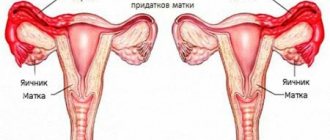Your period is over, and you notice signs of discharge on your panty liner. Is this normal or a disease? Should I consult a doctor or accept the situation without attaching importance to the problem? And is this a problem? The difference between odorless and odorless discharge Women experience vaginal discharge that occurs both after and before menstruation. A sign does not necessarily indicate a disease. The body is cleansed of unnecessary things, protecting the owner from infections. But how to recognize where the norm is and where the deviations are? And what does the beige color of the discharge mean?
Causes of light brown discharge
Light brown discharge can appear in a woman at different phases of the menstrual cycle and even after pregnancy. When is this normal and when is it a sign of illness? Let's look at everything in order.
1st phase of the cycle
The reasons for the light brown discharge, which seems to end menstruation, but at the same time lasts a long time, that is, the length of menstruation in general is more than 7 days - this is most likely not a variant of the norm, but some kind of gynecological pathology. Here you need to pay attention to other possible symptoms:
- infertility (lack of pregnancy with regular and unprotected sexual activity for 2 years);
- severe pain before and during menstruation;
- heavy discharge during menstruation, sometimes the appearance of intermenstrual bleeding.
All these are symptoms of endometriosis - a disease when endometrial cells enter the deeper layers of the uterus and other organs - ovaries, fallopian tubes, abdominal cavity, etc. In severe cases, with a very common process, blood may appear from the eyes and ears during menstruation . This is due to the fact that endometrial cells have reached there too.
How to diagnose the disease and treat it? Uterine endometriosis (adenomyosis) can be diagnosed in advance based on the patient’s complaints and ultrasound examination. And confirm the diagnosis with hysteroscopy. This is a procedure in which an optical device is inserted into the uterus, and the doctor can see with his own eyes the so-called endometriotic ducts in it. Now there is the least traumatic hysteroscopy, which is performed directly at an appointment with a gynecologist, without the use of anesthesia. This is the so-called office hysteroscopy. A thin cannula with an optical device is inserted into the uterus; the woman practically does not feel it.
If endometriosis is diagnosed, the woman is prescribed treatment. It is possible to get rid of completely only from focal endometriosis, for example, from endometriotic ovarian cysts. They are removed laparoscopically. But for diffuse endometriosis, treatment is hormonal, and surgical treatment is used only as a last resort. And this is the removal of reproductive organs affected by endometriosis.
Hormonal drugs include oral contraceptives. If a woman is not planning a pregnancy, this is a very good remedy to stop the spread of endometriosis and improve her well-being. Menstruation will become shorter and less abundant.
If we are talking about an advanced stage of endometriosis, when a woman, for example, cannot get pregnant, then “heavy artillery” may be prescribed, drugs that temporarily introduce a woman into menopause, and the foci of endometriosis quickly decrease. Immediately after treatment, you should try to get pregnant as soon as possible.
By the way, pregnancy is one of the best treatments for endometriosis. The main thing is that it comes.
Mid cycle
1. Hormonal contraceptives. Light brown, odorless discharge after menstruation is usually not a sign of any sexually transmitted infection, but may be a consequence of taking hormonal contraceptives. In the first three cycles of taking them, and sometimes longer, a woman experiences intermenstrual discharge. In the first months of use, this is considered normal, but if it continues for more than 4 months, it requires changing the drug to one containing the hormone estrogen in higher dosages. If this is not possible, then you need to think about changing the method of contraception.
In addition, bleeding may be a consequence of missing or untimely (with an interval of more than 12 hours) taking the drug. Or taking certain antibiotics, anticonvulsants and other medications together with it (they are usually listed in the instructions for the drug). You should also not take contraceptive pills simultaneously with medications containing St. John's wort, its tincture, decoction, etc.
2. Ovulation. This is the time when the egg is released from the follicle and there is a sharp but temporary decrease in progesterone levels. This can cause pinkish, light brown discharge in some women in the middle of the cycle. They usually last no more than 2 days and are not abundant. If you go for an ultrasound at this time, the doctor will be able to determine signs of recent ovulation, for example, fluid in the retrouterine space. Everything returns to normal after the corpus luteum, which secretes progesterone, is formed in the ovary, in place of the follicle. It will continue to work until the end of the menstrual cycle and then disappear if conception has not occurred, that is, there is no need to maintain the pregnancy. And a new menstrual cycle will begin.
Many women use the so-called ovulatory spot to determine the most favorable days for pregnancy. Sexual intercourse during this period of time can lead to the conception of a child.
3. Intermenstrual bleeding. This is no longer the norm. May be a consequence of endometrial hyperplasia, glandular or placental polyp. But the discharge is usually not in the form of a weak smear. It is diagnosed by ultrasound, and surgical treatment involves cleaning the uterus, often in combination with hysteroscopy.
Phase 2 of the cycle
1. Implantation bleeding. If approximately 7 days after ovulation or 5-7 days before the expected start of menstruation, a woman has bleeding, and she has a chance of conception, then you need to keep this point in mind. Light brown discharge before menstruation is a relative sign of pregnancy that many people know about. About 3 days after it, you can already take a pregnancy test and get a reliable result. If it is negative, then it was either not implantation bleeding, or the pregnancy failed, this often happens. Women often have their pregnancies disrupted in this way throughout their lives, but they don’t even suspect it.
Implantation bleeding - what is it?
This phenomenon refers to drops of blood from the vagina, which are associated with the attachment of the zygote to the uterine mucosa. This should not be confused with bleeding as there are very few of them. This condition is not considered a pathological process. However, this phenomenon does not occur in every woman.
Not all female representatives know what this phenomenon looks like. For the most part, there is little blood, therefore, expectant mothers do not notice it. Often, these are bloody streaks in the secretion, a couple of drops of blood on the panties, and rarely - spotting. This phenomenon lasts from several hours to 2 days, but no more.
Implantation process
The main signs of this phenomenon:
- Pain below the navel. They are usually not strong and are associated with muscle contractions during the implantation of a fertilized egg.
- Decrease in basal temperature. What is basal temperature? This concept refers to temperature, which is measured with a thermometer orally, vaginally or rectally immediately after sleep. During pregnancy, basal temperature decreases.
- Scanty white-pink or light brown discharge.
- Excessive weakness.
- Drowsiness.
- Fatigue and dizziness.
It is easy to calculate such a day. The menstrual cycle is 28 days, ovulation occurs on the 14th day. If fertilization does occur, this phenomenon is observed 10 days after ovulation or 7 days before menstruation.
The appearance of beige discharge in women before and after menstruation
When a woman feels great, people living nearby feel extraordinary peace. Children can play their games serenely if the mother is healthy and joyful. The husband enjoys the wife of his youth when she does not groan from the burden of illness. And the woman herself, being strong, enthusiastically takes care of loved ones.
Unfortunately, this picture is often overshadowed by gynecological ailments. The first sign of pathology is vaginal secretion. It is not without reason that the condition of a woman’s reproductive organs is determined by its character.
Even during the process of puberty, an 11-year-old girl develops a secret that indicates the formation of reproductive organs. Later, when the adolescent’s body is ready to reproduce its own kind, the menstrual cycle begins. Under the influence of hormones, the cell in the ovaries matures, the uterus contracts slightly, and a beige discharge comes out. This shows that the reproductive organs are normal.
In older women, such a secretion may indicate abnormalities of the internal genital organs. Should you always worry if you notice a change in the color of your vaginal fluid? The main causes of beige secretion will help you navigate.
Why does discharge with a specific odor appear?
So, we found out above that leucorrhoea is a normal physiological process. However, if such discharge acquires a strong sour odor, itching also appears (which does not necessarily bother you every day) and other unpleasant symptoms, this indicates an ailment such as candidiasis.
There are quite a few factors influencing the onset of the disease:
Taking medications
- hormonal imbalance
- taking certain hormonal medications
- the period of gestation, as a woman’s immunity decreases
- neglect of personal hygiene rules
- incorrectly selected cosmetics for the care of intimate areas
- uncontrolled use of antibiotics
- stress
- unhealthy diet and much more
If such unpleasant symptoms appear, visit a gynecologist. You cannot prescribe medications for yourself, otherwise it will lead to irreparable consequences.
Physiological processes and vaginal secretion
In order not to worry in vain about changes in the shade of vaginal secretion, it is important to know its natural characteristics. Beige vaginal discharge is considered normal; if it does not emit an unpleasant odor. They have medium thickness and do not cause any discomfort.
The natural monthly cycle must correspond to a certain number of days, which is set individually by the body. For some it is 30 days, and for others 21 days is enough. It all depends on the internal characteristics of the body.
The day before the onset of menstruation, the endometrium is shed in the uterus. As a result, a woman develops beige discharge before her period, which gradually turns into blood. Such physiological processes are not dangerous to the health of a mature lady. The main reasons for this phenomenon:
- internal hormone surges;
- factors of maturation of reproductive organs in adolescents;
- changes during menopause.
In addition, such an imbalance occurs due to negative emotional stress. Also, disruptions in the endocrine system and insufficient amounts of vitamins in the body lead to the appearance of beige discharge. Thus, internal physiological processes are closely related to vaginal secretions.
Natural reasons for the detection of light brown secretion are often associated with pregnancy. Ladies who do not want to have children take oral hormonal medications. They, in turn, influence the process of egg formation, which is reflected in vaginal secretions. Mucous discharge after ovulation of a beige hue indicates the completion of the process. In some cases, oral contraceptives delay the rupture of the follicle, and a beige secretion appears at a certain DPO (day after ovulation).
When fertilization occurs in a woman and the embryo attaches to the wall of the uterus, a beige or pinkish liquid enters the vagina. Some ladies mistake this secret for the beginning of menstruation.
Light beige discharge that gradually darkens in pregnant women often indicates the possible loss of the baby. To avoid an accident, you should consult a doctor for advice. Timely advice received can save the life of an unborn child.
Often, menstruation ends with smears of beige-brown discharge, which includes remnants of the endometrium, mucous tissue and ichor.
During the first sexual intercourse, the hymen is torn. As a result, discharge occurs, which flows out over time. In addition, the girl feels pain in the lower part of the pelvis, which is repeated every time after intimate intercourse. If the beige tint does not stop within 10 days, you should seek advice from a gynecologist.
A natural physiological process is beige discharge after menstruation in the form of small smears. The main reasons for such phenomena are the individuality of the reproductive organs or the bending of the uterus.
Information in a notebook.
- Beige-colored secretion in the first phase of the menstrual rhythm is considered normal if it does not smell of anything and is in small quantities.
- Discharge after ovulation is light brown in color and usually increases in volume.
- The second phase of the monthly cycle is characterized by a decrease in the volume of secretions, which becomes much lighter.
- Beige vaginal fluid before the onset of menstruation is considered normal, even if it increases in quantity.
Every woman is able to analyze the nature of her vaginal discharge to determine the degree of danger.
Diagnostics and therapy
The doctor conducts a gynecological examination and makes a smear from the vaginal wall. Then he is sent to the laboratory for blood donation. sometimes a woman also needs to undergo an ultrasound, do an extended video colposcopy, and wait for the results of bacteriological and biochemical studies. If the cause is not determined, additional diagnostics may be required to identify cancer.
Therapy begins after the examination has established diagnoses: follicular cyst, polyps, infection, damage to the mucous membranes, and so on. Now they use a medicinal method (conservative method) to eliminate pathologies and practice surgical intervention. Among the drugs prescribed are hormonal, anti-inflammatory, antibacterial, stimulating uterine tone.
Prolonged discharge instead of menstruation (more than four cycles), which occurred as a result of taking oral combined contraceptives, cannot be treated. Since they often occur due to incorrectly selected hormonal drugs, the doctor stops taking them. Then he prescribes a biochemical blood test and, based on the new results, other contraceptives are selected.
Menstruation requires immediate treatment if it is systematically accompanied by frequent surges in blood pressure, foul-smelling beige discharge, or poor health: weakness, increased sweating, fever. A woman who has an IUD should immediately go to the hospital to remove this foreign body, cleanse the lining inside the uterus, and detoxify the body.
If there is a threat of miscarriage before 8 weeks (symptoms: creamy, pink, beige discharge instead of menstruation), the obstetrician-gynecologist refers the pregnant woman for an ultrasound examination. The expectant mother must comply with bed rest and comply with all medical prescriptions if she wants to keep the child.
Beige discharge in gynecology: listen to your body's signals
The nature of a woman’s discharge constantly changes along with the periods of the menstrual cycle. But there are physiological and pathological factors that affect their composition and quality. This article will explain what you should pay attention to and when to see a doctor if beige discharge appears before your period, after it, and at any other time of the cycle.
Norm or pathology
The causes of dark brown discharge that appears instead of menstruation may be natural processes that do not require medical correction. Or maybe pathological disorders that need to be treated. It is impossible to find out on your own what causes this condition.
If we talk about pregnancy, then brown discharge before menstruation and its subsequent cessation may be a symptom of the attachment of the fertilized egg (so-called implantation bleeding).
But bleeding during the period of expected menstruation may indicate a threat of interruption caused by various factors. Also, the pregnancy may be ectopic or frozen, which requires immediate medical intervention. After all, brown discharge is nothing more than blood in small quantities that has managed to coagulate.
It cannot be reliably stated that spotting before menstruation is a sign of pregnancy. The appearance of such discharge prompts the gynecologist to think about a hormonal imbalance. Also, unusual periods can be the first sign of infectious, inflammatory diseases or pathologies of the cervix.
Brown discharge after conception should alert a woman. If the pregnancy is planned, you should urgently consult a doctor. After diagnosis, it will be possible to talk about normality or pathology, and, if necessary, take some action.
Characteristics of the symptom
The definition of “beige” is a collective concept. This category includes light discharge of a brown, yellowish-milky, creamy hue. They have a liquid, thick consistency, abundant and spreading. They consist mainly of mucous secretion produced by the glands of the genital organs, the nature of which varies depending on hormonal fluctuations, various physiological conditions of the female body or pathologies.
Spotting Yellow-beige discharge Spotting creamy discharge Light beige discharge
Beige-brown discharge occurs when blood is added to the mucus. It acquires this color if blood is released in small quantities and coagulates in the genital tract. The beige-yellowish and milky tint is caused by a change in the composition of the microflora, as well as the presence of a possible inflammatory or infectious process.
Beige discharge can be indicated immediately before menstruation, after it, in the middle of the cycle (during ovulation), which is a normal phenomenon that can be associated with physiological changes. But the designation of discharge at other times without reference to regulations or the release of the egg from the follicle becomes a reason to consult a doctor.
There are several causes for the described symptom:
- The course of the menstrual cycle.
- Hormonal and endocrinological disorders.
- Use of contraceptives with and without hormones.
- Allergic reaction.
- Sexual contact.
- Pregnancy.
- Age factor.
The main criteria by which beige-colored physiological mucus can be distinguished from a symptom of the disease are the absence in the first case of an unpleasant odor, specific sensations (burning and vaginal itching, pain in the lower abdomen, discomfort during sexual intercourse), uniform consistency, and normal urination. The presence of at least one sign from this list should alert you.
Doctors' opinion
Studying the recommendations of gynecologists allows us to draw the following conclusions:
- The appearance of light brown spotting before the onset of menstruation is a pathological reaction.
- Beige discharge in the middle of the cycle can tell about the conception of a child.
- At the end of menstruation, spotting is possible - this is the destruction of the endometrium.
- Beige discharge at 5 weeks of pregnancy is a reason to visit a gynecologist.
- Methods of ensuring hygiene during menstruation have been changed - pads, tampons, which may also cause uncharacteristic discharge.
- Discharge may appear if a woman uses low-quality underwear.
- Smearing after or before the regula may indicate an allergic reaction.
Self-diagnosis and self-medication can only worsen your health condition. To prevent events from developing into a similar situation, it is important to urgently visit a specialist.
An examination by a doctor means performing modern diagnostic procedures:
- taking blood tests;
- examination on the couch and on the chair;
- obtaining a smear;
- Ultrasound;
- performing colposcopy.
To perform the above steps, you must contact a gynecologist.
Sign on different days of the menstrual cycle
Before your period
The appearance of this symptom before menstruation is associated with hormonal changes. At this moment, the increased work of progesterone is aimed at rejecting the endometrium and preparing for a new cycle. Under the influence of this hormone, the mucous membrane of the uterus, a day or two before the start of menstruation, goes into full readiness for excretion and becomes swollen and loose, letting you know about this with a small amount of blood, which coagulates and is indicated at the exit by a beige or brown daub before menstruation. Following this, critical days should begin.
When discharge of this kind appears earlier than two days before menstruation, or it smells unpleasant and echoes discomfort in the intimate area, a disease can be suspected.
After menstruation
Beige discharge after menstruation is a natural continuation of it. They are explained by the fact that the blood does not disappear abruptly, but after complete rejection of the endometrium, it ceases to be produced gradually, and part of it coagulates in the genital tract, eventually leaving it along with mucous secretions. This is an acceptable norm when there is no time gap with critical days. When it smears after menstruation a week or two later, there is a possibility of a pathological process manifesting itself.
White discharge as the main sign of pregnancy
Scientists have proven translucent mucus 3-4 days before the estimated date of menstruation indicates pregnancy. In this case, the mucus does not change color and does not entail a specific odor. The main thing during this period is daily washing 2 times a day. Otherwise, the secreted secretion will cause bacteria to multiply.
The introduction of a single-cell embryo into the wall of the uterus occurs after approximately 7 days - this is the 23rd day of the cycle. This condition is accompanied by bleeding.
After conception has occurred, the female body begins to produce a huge amount of the hormone progesterone. It promotes the formation of placental protection, and before that the mucous plug. This is why a woman experiences thick, clear discharge until the 2nd trimester of pregnancy. This is the norm, not a pathological process.
Onset of pregnancy
Sometimes pink or light brown mucus appears without odor or discomfort. This indicates the attachment of the fertilized egg to the uterine mucosa.
The fetus begins to actively change on the 21st day of the cycle and this coincides with the bright symptoms of pregnancy. During this period, the expectant mother begins to react vividly to various smells. This condition is accompanied by nausea, breast enlargement and tenderness.
After the egg takes its place, and this occurs approximately on the 25th day of the cycle, the expectant mother feels a nagging pain below the navel, and there is spotting, but usually not much.
In a normal cycle, your period comes on the 28th day. Their absence and the signs indicated above indicate successful fertilization.
Mucus can accompany the entire pregnancy. Very often, before childbirth, their volume increases sharply. The presence of pathology is indicated by a change in the shade of mucus. If this happens, contact your gynecologist in a timely manner, because we are talking not only about your health, but also about the health of the baby.
Discharge due to an allergic reaction
Such secretion sometimes occurs as an allergic reaction to contraceptives, intimate hygiene products, synthetic underwear, lubricants, and even drugs used to treat ailments not related to the reproductive system.
To eliminate allergic manifestations, it is necessary to remove the irritant.
There are common cases when female organs react in a similar way to the installation of an intrauterine device. The first few days after its implementation, minor deviations from the usual discharge are acceptable. But if they change their color to brown, beige, pink and bloody and last a long time, then you should consult a gynecologist about removing the contraceptive.
As a symptom of inflammatory processes
When beige mucus flowing from the vagina is accompanied by clinical manifestations such as pain in the lower abdomen, discomfort during intercourse or urination, as well as itching and burning, this indicates a serious disorder. Such symptoms signal the penetration of infection and the beginning of the inflammatory process:
- endometritis – inflammation of the uterine layer of the endometrium;
- adnexitis - inflammation of the appendages and fallopian tubes;
- colpitis - develops in the vagina and is triggered by infection and disruption of the normal microflora.
Inflammatory processes occurring in the reproductive organ manifest themselves with vivid symptoms before the arrival of the regula and after their completion. They are characterized by the appearance of brown and beige secretions, which are accompanied by pain, hyperthermia and an unpleasant odor.
Inflammation in the vagina develops due to the penetration of pathogenic microorganisms. Among the pathologies that can provoke this process are the following:
- Bacterial vaginosis. In the case of the development of this disease, the appearance of mucous yellow or dirty beige discharge with the smell of rotten fish, which intensifies after intimacy, as well as itching and burning, is noted.
- Candidiasis. A pathology of a fungal nature, in which a cheesy discharge of beige, cream or white color with a sour odor is observed.
A similar shade of mucus often indicates the development of endometriosis, fibroids, the growth of polyps in the reproductive organ or neoplasms in the cervix and tubes. Clinical manifestations of these diseases are observed on any day of the cycle, but are often observed closer to the approach of menstruation or several days after its end.
It is impossible to determine the cause of the appearance of beige secretion at home. If a connection with the cycle is excluded, then you need to consult a gynecologist and identify the factor that led to such changes.
During sexual contact
During sexual intercourse, the vaginal glands secrete more than the usual mucous secretion, which may have a cloudy light color.
When sexual contact ends with ejaculation, after it a woman sometimes observes a thick discharge from her vagina, reminiscent of egg yolk, creamy or beige in color. This is the trapped sperm and female lubricant coming out.
Normally, discharge after coitus should not have a specific odor and be accompanied by itching.
Leucorrhea in the absence of menstruation
Leucorrhoea in the absence of menstruation can be normal or pathological. It all depends on a number of reasons, which you will find out below.
Main reasons:
- Pregnancy is considered one of the main causes of mucus.
This is explained by the fact that the woman’s body protects the cervix from the penetration of bacteria, so a mucous plug forms in the vagina. It leaves its walls several hours before the birth process begins. The plug is the main reason for the appearance of clear or translucent mucus when menstruation is delayed. Character of leucorrhoea - Hormonal imbalance. It is the female sex that is most susceptible to this condition, therefore, even a minor deviation can lead to the appearance of leucorrhoea.
- Stress. The female reproductive system and the menstrual cycle are extremely dependent on negative external influences. Consequently, when stressful situations arise, menstruation may shift by 2-3 days, and leucorrhoea will appear.
- Excessive training. Especially if the start of sports activity was too intense, this may provoke the appearance of discharge.
- Pathological or inflammatory processes. Severe illnesses can delay the appearance of menstruation and cause discharge. Moreover, if in the first 2-3 days they are white and the woman does not suspect anything, then over time the discharge acquires a yellowish tint. After which other symptoms arise: itching, a specific odor and pain.
- Cervical erosion. Now such pathology can be found in every third woman. You should know that in this case, periods come on time, but their delay may be caused by another factor.
If your period still does not appear, but instead there is a clear discharge, you must definitely visit a gynecologist.
During pregnancy
Beige vaginal discharge can help a woman know she is pregnant. Such a sign at the beginning of an interesting position is natural and indicates the moment of conception, when a fertilized egg is introduced into the uterine cavity. This is how the main female organ reacts to a body that is still foreign to it. Beige, light brown, and even bloody discharge is often observed for several days during early pregnancy.
In the first month of the gestation period, a sharp hormonal change begins in the body of the expectant mother, and therefore the nature of the secreted secretion may change in color and quantity. White, yellow, beige, greenish vaginal discharge is acceptable, but provided that it smells normal, does not contain blood or pus, and does not cause discomfort or pain.
Any change in these characteristics should be immediately accompanied by a trip to the gynecologist.
Causes
The secret of beige color is due to physiological and pathological processes occurring in the body. Before the arrival of the regulus and during the period of ovulation, this is considered normal and does not cause concern.
Women often note that light beige discharge occurs in the early stages of pregnancy. Hormonal changes during puberty or while taking oral contraceptives can provoke the appearance of an uncharacteristic secretion.
Such symptoms may also indicate problems with the endocrine system, hormonal imbalances, allergies, the development of infectious diseases or the onset of an inflammatory process.
Age factor
Age-related changes play a significant role in the quality of the secretion produced. From the moment of puberty until the completion of reproductive function, representatives of the fair sex observe all kinds of discharge.
With the onset of menstruation in girls, over the course of 1–2 years, the composition of sexual mucus constantly changes under the influence of fluctuations in hormone levels. Unstable hormonal levels during this period can manifest themselves as beige intermenstrual discharge, as well as this symptom instead of menstruation.
A similar picture emerges with the onset of menopause. A woman experiences disruptions in her menstrual cycle, unusual discharge and other changes due to insufficient estrogen production during menopause. This can explain similar symptoms before the menopausal stage. After it, any specific blood secretion should be a cause for concern.
Why do I have brown discharge if I'm not pregnant?
Brown spotting before or instead of menstruation can occur in pathological conditions and diseases of the pelvic organs. A comprehensive examination, which includes:
- vaginal smear;
- Ultrasound;
- blood tests;
- colposcopy;
- laparoscopy.
Hormonal changes
Light brown discharge instead of menstrual bleeding occurs in girls during puberty. During the first year from the start of menstruation, the cycle is established. The body adapts to new functions. Periodic failures, disturbances, spotting are normal if not accompanied by additional signs of pathology.










